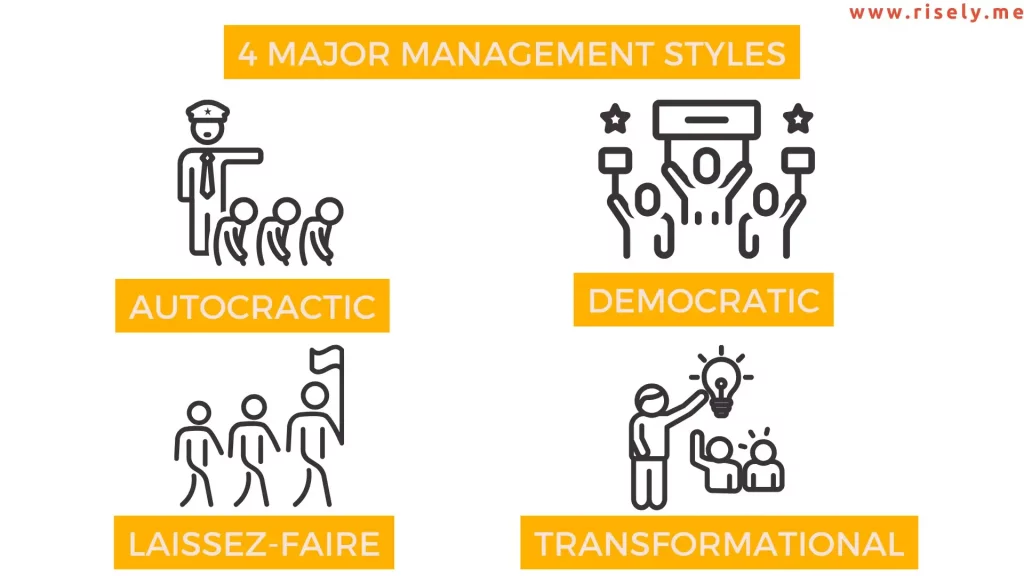4 Major Management Styles And How To Ace All
Effective management skills are essential for success in any organization. Managers are crucial in guiding and supporting their teams to achieve organizational goals. However, there is no one-size-fits-all approach to management. Different situations and teams require different leadership styles to maximize employee productivity and engagement. By understanding the four major management styles and their characteristics, leaders can adapt their approach to meet the needs of their teams.What are the 4 Major Management Styles?
There are four major management styles that leaders can adopt:
Autocratic Management Style
The autocratic management style is known for its centralized decision-making process. In this style, the manager makes most of the decisions without consulting team members. This approach can be effective when quick decisions are needed, such as during crisis situations. However, it can also lead to a lack of employee engagement and creativity. Team members may feel restricted and less motivated to contribute their ideas and suggestions.
When to use the autocratic management style:
- During emergencies or crisis situations
- When strict deadlines must be met
- In hierarchical organizations where a centralized decision-making process is the norm
When not to use the autocratic management style:
- In situations that require innovation or creative problem-solving
- During team-building activities
Democratic Management Style
The democratic management style is characterized by collaboration and inclusivity. In this style, the manager involves team members in decision-making and values their input. This approach fosters employee engagement and empowerment. Team members feel valued and motivated to contribute their ideas and perspectives.
When to use the democratic management style:
- When decisions require input from various stakeholders
- When you are building a sense of ownership among team members
- In organizations that value diversity and inclusivity
When not to use the democratic management style:
- In urgent situations where immediate action is required
- In organizations where top-down decision-making is preferred
- In situations involving sensitive or confidential information
Laissez-faire Management Style
The laissez-faire management style is characterized by a hands-off approach. In this style, the manager gives team members autonomy and allows them to make decisions independently. The laissez-faire management style can be effective when team members are highly skilled and self-motivated. It promotes employee creativity and innovation by allowing team members to approach tasks in their own way.
When to use the laissez-faire management style:
- When team members possess a high level of expertise and self-motivation
- In environments that encourage innovation and creativity
- In settings that value flexibility and adaptability
When not to use the laissez-faire management style:
- With inexperienced or newly formed teams that require guidance
- In situations where adherence to timelines is critical
- In projects that require coordination and collaboration among team members
Transformational Management Style
The transformational management style inspires and motivates team members to achieve their full potential. Transformational leaders are visionary and encourage their team members to think outside the box and embrace change. They inspire their team with a compelling vision and create a positive work culture.
When to use the transformational management style:
- During periods of organizational change or transformation
- In initiatives that require a clear vision and direction
- In fostering personal and professional growth among team members
When not to use the transformational management style:
- In routine or repetitive tasks where innovation or motivation may not be necessary
- In environments where employees are not receptive to visionary leadership
- In short-term projects with specific, limited objectives
Other Interesting Reads
Transitioning Between Management Styles
Transitioning between management styles is critical for leaders to adapt to changing circumstances and effectively lead their teams. Effective leaders recognize that no management style fits all situations and can shift their approach as needed. Understanding the strengths and weaknesses of different management styles and assessing the organization’s and team members’ needs can guide the transition. Flexibility, open communication, and the ability to assess and adapt to the situation are key to successfully transitioning between management styles.How do management styles affect team performance?
Management styles have a significant impact on team performance. A democratic management style, for example, promotes collaboration and empowers team members to contribute their ideas and expertise, leading to improved team performance. On the other hand, an autocratic management style can stifle creativity and innovation, potentially hindering team performance. Transformational leadership, which focuses on inspiring and motivating employees, can drive higher levels of employee engagement and development, resulting in improved team performance. The choice of management style directly influences team dynamics, employee motivation, and overall productivity.When to Shift Your Management Style?
Different management styles have their strengths and weaknesses, and the key to success is selecting the right style for the situation, considering factors such as work environment, company goals, and employee engagement. Shifting your management style is essential when the situation demands a different approach. Situational leadership requires leaders to assess the organization’s team’s needs and external factors to determine the most effective management style. For example, in times of crisis or high-stakes situations, an autocratic management style may be necessary to make quick decisions and maintain order. In periods of organizational change, a transformational management style can inspire and motivate employees. Recognizing when your current management style is not yielding the desired results or when external factors require a different approach is crucial. It is important to be adaptable and willing to step out of your comfort zone to meet the organization’s and team’s evolving needs.How to Develop Contextual Management Skills?
Developing new management skills is essential for personal and professional growth as a leader. To enhance your management skills, consider the following strategies:- Continuously learn and educate yourself about different management styles and approaches.
- Seek out mentorship or coaching from experienced managers or industry experts.
- Take on new challenges and responsibilities to expand your skill set.
- Actively seek feedback from peers, subordinates, and superiors to gain insights into your strengths and areas for improvement.
- Attend workshops, seminars, or training programs focused on leadership and management development.
- Develop a coaching style by providing constructive feedback and guidance to your team members.
- Cultivate self-awareness and reflection to identify areas for growth and improvement.
- Set goals for yourself and regularly assess your progress and development.
Conclusion
In conclusion, mastering various management styles is crucial for effective leadership. Understanding the nuances of autocratic, democratic, laissez-faire, and transformational styles allows you to adapt to different situations and lead your team to success. Each style has pros and cons, impacting team dynamics and organizational outcomes. You can enhance team performance and drive positive organizational change by identifying your preferred style and learning to transition between styles when needed. Embracing flexibility in management styles empowers you to navigate diverse challenges and inspire your team toward shared goals.How strong are your core people management skills?
Master people management today, starting with free skill assessments on Risely.
Other Related Blogs
6 Essential Coaching Skills for Leaders and How to Develop Them
6 Essential Coaching Skills for Leaders and How to Develop Them Fulfilling the job of a manager needs us to wear multiple hats. Often, we find ourselves guiding our team…
Supervisor vs Manager: Understand the Differences And Which Best Suits You
Supervisor vs Manager: Understand the Differences And Which Best Suits You Supervisor vs Manager: Which role suits you best? Are you ready to take charge and lead a team? Or…
What is the Coaching Leadership Style? Explained with 5+ Examples
What is the Coaching Leadership Style? Explained with 5+ Examples Leadership is like having a toolbox full of different tools. Each tool has its purpose, and as a leader, it’s…
Systems Thinking In Management: Why And How To Adopt
Systems Thinking In Management: Why And How To Adopt The way managers think is of massive consequence. After all, their thoughts turn into actions that take teams forward. While the…


